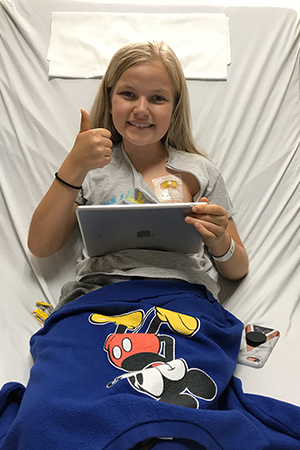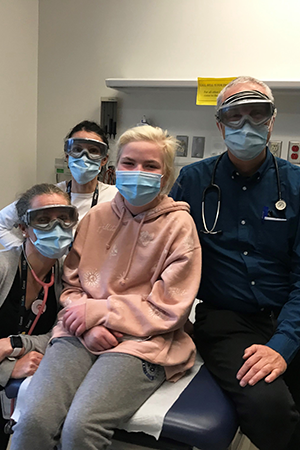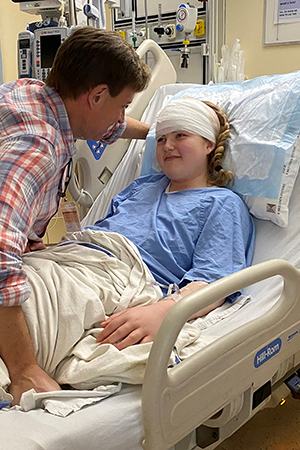Molecular testing unveils new insights into adolescent and young adult brain cancer
Summary:
Research highlights the need for age-specific treatment strategies that consider a tumour’s molecular origin, not just patient age at diagnosis.

Camryn was diagnosed with a low-grade glioma at age two after her parents noticed a lazy eye.
Sixteen years, 11 brain surgeries and over six years of chemotherapy treatment, Camryn is now transitioning from The Hospital for Sick Children (SickKids) into adult care. Recent findings from specialized molecular testing have provided new insights into her condition. Part of a broader research study, the findings are helping to shape potential treatment approaches for patients with glioma based on the molecular origins of their tumours rather than age alone.
Camryn’s tumour was one of 1,500 gliomas from children, adolescents and young adults analyzed in a SickKids-led study recently published in Nature Cancer. The research team found that one-third of gliomas in people aged 15 to 39 had genetic changes typical of childhood glioma. While some subgroups were linked with better outcomes, others became more aggressive during this critical age window.
“We identified subpopulations of people with glioma who may benefit from completely different treatment approaches. With this knowledge, we can intercept the cancer earlier based on its molecular origins,” explains Dr. Cynthia Hawkins, co-lead of the study, Neuropathologist in the Department of Paediatric Laboratory Medicine and Senior Scientist in the Cell & Systems Biology program.
Early interception informed by molecular testing
While gliomas are the major cause of cancer-related death in adolescents and young adults, there are distinct differences between gliomas that occur in children versus older adults, and treatment can vary depending on someone’s age at diagnosis.

Like many children with brain cancer, Camryn's doctors initially opted to ‘watch and wait,’ balancing treatment risks with her developing brain. But at 15, her tumour rapidly progressed, requiring an 18-hour surgery that removed a large portion of the tumour but left her paralyzed on one side of her body.
Molecular testing through this research study later identified Camryn’s glioma had a variation in the FGFR gene.
In a subgroup of paediatric-like low-grade gliomas in adolescents and young adults, the study found the tumours occur in different locations between these age groups and older patients have better outcomes than in children, despite their similar molecular origins.
Conversely, some types of childhood gliomas with variations in the BRAF and FGFR genes, like Camryn’s, seem to undergo significant changes in the adolescent and young adult period, becoming more malignant and requiring intervention.
“Without the right molecular testing, many of these adolescents and young adults may have been over- or under-treated for their glioma,” says Dr. Uri Tabori, co-lead author on the paper, Head of Neuro-Oncology, and Senior Scientist in the Genetics & Genome Biology program. “These findings can help us develop novel strategies to treat patients at the right time and help preserve their quality of life.”
Spurred by the need for a more collaborative approach to treating these tumours, Dr. Julie Bennett, first author, Project Investigator and Staff Physician at SickKids, together with Drs Hawkins, Tabori and Lim-Fat created and co-leads the Canadian Adolescent & Young Adult Neuro-Oncology Network (CANON), a national collaboration that brings together multidisciplinary providers like Dr. Peter Dirks, to improve care and outcomes for adolescents and young adults with brain tumours.
“Understanding which molecular tests to order and for what conditions is complex and access may be limited in remote areas. We are helping to educate care providers on the tests available to them and improve access to molecular testing for adolescents and young adults across Canada,” says Bennett.
Building a care network for adolescents and young adults

After three years of rehabilitation to regain the use of part of the right side of her body, Camryn is beginning her transition to adult care centres and is part of the newly created neuro-oncology clinic dedicated to adolescents and young adults with paediatric-type brain tumours. The clinic is led by Bennett, who is now cross appointed at Princess Margaret Cancer Centre.
“There’s a part to leaving the hospital that’s incredibly stressful,” explains Camryn’s father, David. “This clinic offers comprehensive support for Camryn and our family to ensure she is receiving the best care possible tailored to her specific tumour.”
Hawkins and colleagues advocated for inclusion of paediatric-type versus adult-type glioma categories in the WHO classification of CNS tumours to increase awareness, improve outcomes and drive further research.
"Now that we know these differences exist, we can adjust our practices and better support this overlooked population,” she says.
Camryn, who is preparing to enter college, says she hopes to rejoin the hospital as a Child Life Specialist to help other patients and families navigate their own journeys.
“If we continue to support more research, I’m optimistic that they will find a cure one day,” she says.
This research was funded by the Garron Family Cancer Centre, Children’s Oncology Group, Brain Tumor Foundation of Canada, SickKids Clinician Scientist Training Program, Canadian Institutes of Health Research (CIHR), b.r.a.i.n.child, Canadian Cancer Society, Cancer Care Ontario (CCO), National Cancer Institute and Memorial Sloan Kettering Cancer Center.

